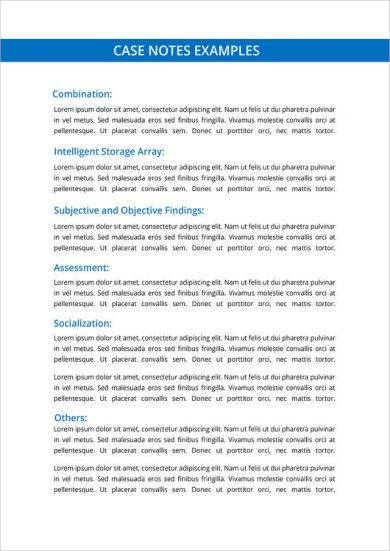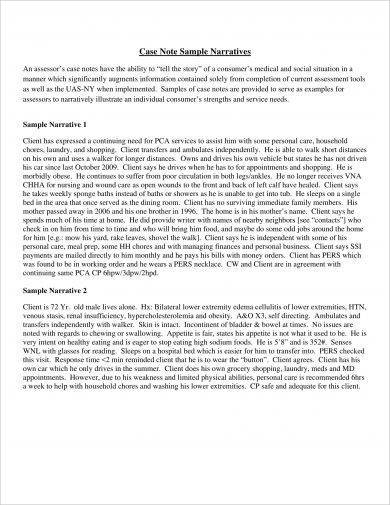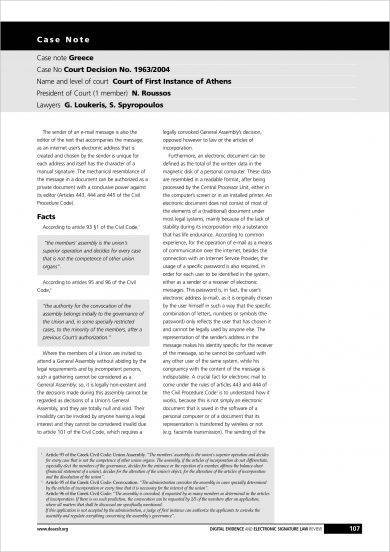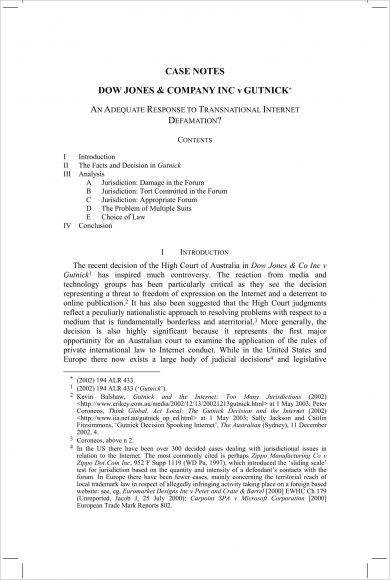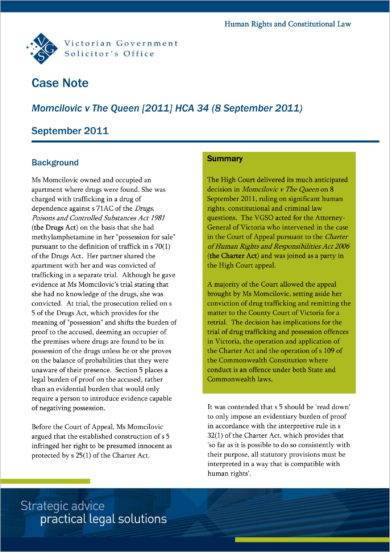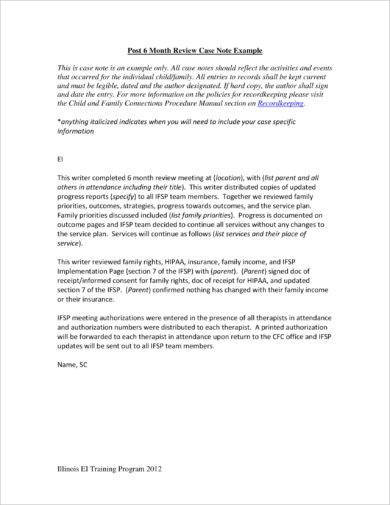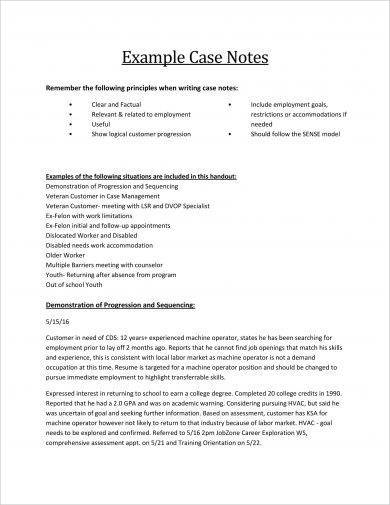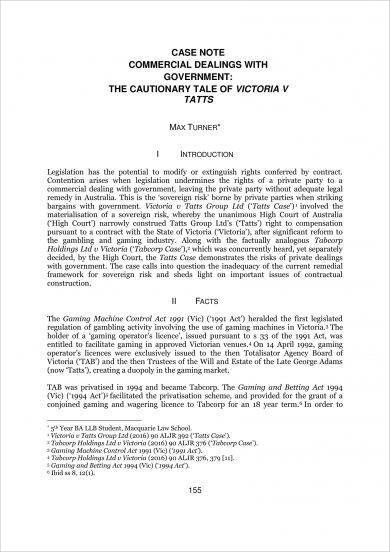10+ Case Note Examples to Download
There are certain times in our lives that we miss to perform some tasks because we simply forgot about them and we do not have any reminders or notes to remind us the things that we still need to complete. You may also see meeting note examples.
We do not have any excuse but to say we failed to remember them. There are also instances when we want to remember a certain event on a certain day to trace what we have been doing for the whole day on that certain day, but we don’t have any clues on what happened that day. It is indeed true that humans are innately forgetful except those with special skills of memorization. You may also like welcome note examples.
When it comes to cases, it is also important to keep a record of previous cases including the exact and complete details of such case. This must be in a form of a case note. Case notes not only are a set of reminders of a previous interaction but also document referrals and decisions, identify setbacks, provide helpful insights, and can also be used as an evidence. You see, there are a lot of reasons why one must have a case note. You may also check out what is a note?
Below are helpful examples that you can refer to in case you need a reference, and a full discussion with regard to case notes is presented in the next section.
Case Notes Example
Case Note Sample Narrative Example
Case Note Template Example
What Is a Case Note?
Case notes refer to the notes taken by a doctor, lawyer, or social worker with regard to a certain case that they are working on. These are closely similar to a journal article, but it analyzes a certain case. The citation in a case note is similar to that in a journal article. In cases when the case note you need to cite does not have a title, you can use the name of the case in italics and add a note at the end of the citation. You may also see note examples in pdf.
Case notes do not have to address every aspect or issue in a particular case but only those that are significant.
Purpose of Case Notes
Taking time to write good case note is important as this can help you organize or manage cases. They are particularly important because
- they are a set of reminders of the interactions with a service user;
- they are a set of reminders for the service user who might forget the useful information about the services they have received;
- they document referrals to programs and services relating to the case note;
- they document that decisions that has been made as well as the rationale for those decisions;
- they are helpful in keeping track of a service user’s progress and setbacks;
- they help to identify emerging challenges so that the user can address those challenges;
- they provide helpful insights to others who are legally authorized to read the case notes;
- they provide a background of a certain case in case it is transferred to another settlement worker’s case load; and
- they can be used as an evidence in some legal matters.
You may also like nursing note examples.
Contract Law Case Note Example
Detailed Case Note Example
Dow Jones and Co. Inc. vs. Gut Case Note Example
Momcilovic vs. The Queen Case Note Example
Privacy and Confidentiality with Case Notes
Case notes are indeed a valuable record of the past services provided. However, they must also be kept confidential and respect must be paid to the service user. Disclosing a highly sensitive information may cause harm if inappropriately disclosed to a family member, legal professional, or other third parties. The case note writer is held responsible for the privacy of the case notes. You may also see note templates & examples.
When we say highly sensitive information, this could be the following:
- living arrangements as well as address
- relationship status
- financial status
- psychiatric/medical history or conditions including treatments and prescriptions
- evidence of addictions like drugs, alcohol, smoking, and gambling
- experience with violence
- cultural practices
- criminal history or involvement
- past or current charges or violations of the law
You may also like chart note examples.
Case Note Tips
A case note should be as follows:
- clear
- brief and concise
- precise and accurate
- specific
- complete
- timely
- no material typographical errors
- describe relevant observed behaviors without having personal judgement or interpretation
- document users’ verbal statements and questions without personal judgment or interpretation
- record objective observations
- confirm conclusions and decisions through the evidence and facts presented
On the other hand, a case note should not
- contain personal judgement or interpretation,
- use pronouns in place of names,
- use abbreviations that are not common,
- contain jargon and technical words,
- contain cliches,
- contain stereotypes and prejudices, and
- use gender-specific language.
You may also check out blank note examples.
Noteworthy Aspects to Understand Case Note Features
Below is a list of noteworthy aspects that may assist you in understanding the features of a case note:
- A significant aspect or area of concern
- The probability that there might be intriguing results in later cases
- The court ignores logical reasoning
- The court did not follow the majority of jurisdictions
- The first case in a newly designated place
- A likely effect on areas like business, consumers, employment, education, and other extra-legal areas
You might be interested in loan note examples.
Format of a Case Note
To manage and organize the content of your case note, you must ensure that it is complete and it follows a certain format. The format below is commonly used in most case notes.
1. Introduction
In your introduction, you must briefly describe the area of the law and the organization of the note to your reader. This will give him or her a background on what your case not is all about.
He or she will be briefed with regard to the applicable law. A few but forceful lines may suffice as your introduction, introducing in brief what the case note is all about. This part should be simple and comprehensible, but this does not necessarily have to be a long paragraph. A concise and precise one is better. You may also see progress note examples.
2. Facts
Present facts that are relevant, clear, and concise in an interesting manner. You may never present the small and not necessary details but only those that are relevant and with great impact to the whole case.
You must remember that the idea of writing a case note is to focus the reader’s attention on the facts that are critical or those that controls the issue. Also present the information with regard to the lower court’s holding, appeals, and any subsequent action related to the case. You may also like delivery note examples.
3. Holding
Present the court’s holding on a certain relevant issue. Only choose those that are relevant, and you may disregard the irrelevant ones.
Make sure that you carefully eliminate those that are with zero to less significance or else the information you present is not complete and precise. Also, do not forget that you must not include your personal interpretation with regard to the court’s holding on a certain case for there are instances that you incorporate in the case note your personal judgment not knowing that you have already done so. You may also check out doctor note examples.
4. Background or Discussion of Prior Law
Present the relevant background law that relates to the case. Again, only present those that are relevant so that the readers will not be confused on the law that is related to the issue.
You must also describe the existing law as well as its development. To close this section, you must present the relationship of the selected issue or case and illustrate how that issue or case affects the prior law. This is to provide the information and the knowledge about the law where such issue connects. You might be interested in thank-you note examples.
5. Analysis
In this section, you are allowed to describe and critically analyze the court’s decision. You can express your original ideas; however, you must remain objective. If and when the evidence support your reasoning, say so and sustain your conclusion.
Do not be afraid to present the law as you contend it is or ought to be in its full context. You may also address vague and ambiguous statement stated by the court as well as questions the court left unanswered. In this section, you will have the opportunity to demonstrate your legal skill and prowess through raising important issues as well as dissecting the different important parts of the tackled issue. You may also see what is a briefing note?
6. Conclusion
In this section, your exclusive use as an author is reserved. Just like any other write-ups, you are required to make a conclusion and an overall note of your case note. You must summarize and highlight the important points in the discussion. You may also like tips for writing a thank-you note.
Post Six-Month Review Case Note Example
Simple Case Note Example
Unicram Case Note Example
Victoria vs. Tatts Case Note Example
Final Note
Now, it is expected that we already know how important it is for one to have a case note since it reminds one of his interactions, documents the past decisions, keeps track of setbacks, identifies challenges, can be used as an evidence, and a lot more. You may also see release note examples.
However, although a case note contains information that are already being discussed in the past, certain information must be kept confidential such as the address or addresses mentioned in the case, relationship and financial status, medical history, psychiatric, or criminal history, violations of the law, among others. You may also like credit note examples.
For a case note to be organized and presentable, it must be clear, concise, complete, timely, free from bias and personal judgment, and free from material typographical errors. It must not contain personal interpretation, pronouns, uncommon abbreviations, jargon, cliches, stereotypes, and gender-specific language. You may also check out field notes examples.
To have a complete and smooth flow of a case flow, it must contain the following elements and format: introduction, facts, holding, background, reasoning, and conclusion.
To get a firm grip on the content of a case note, you may refer to the examples of case notes presented in the above section.



